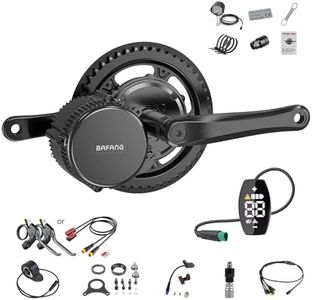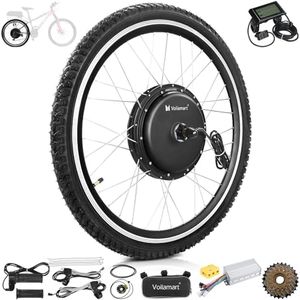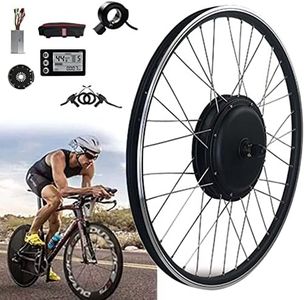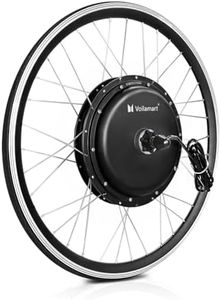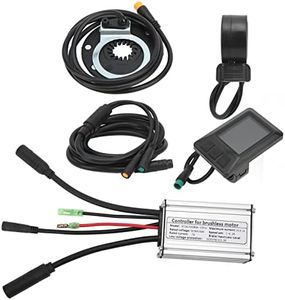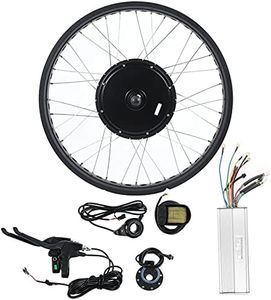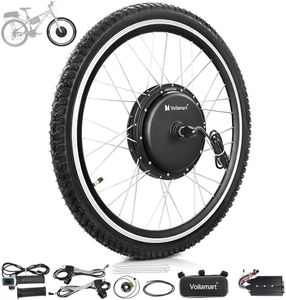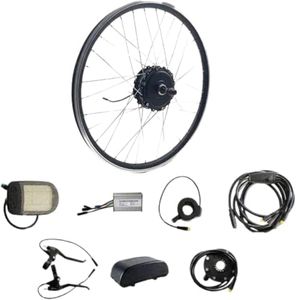We Use CookiesWe use cookies to enhance the security, performance,
functionality and for analytical and promotional activities. By continuing to browse this site you
are agreeing to our privacy policy
10 Best Electric Bike Conversion Kits
From leading brands and best sellers available on the web.Buying Guide for the Best Electric Bike Conversion Kits
Choosing an electric bike conversion kit is a great way to upgrade your regular bicycle into an e-bike without buying a brand new vehicle. The key to picking the right kit for you is to understand your riding needs—think about where, how often, and how far you’ll ride, and what you expect from electric assistance. Start by considering what type of bicycle you have, the type of roads or terrain you’ll cover, and the level of installation difficulty you’re comfortable with. This helps guide you toward a kit that matches your daily routine and technical skills.Motor TypeThe motor is the heart of an e-bike conversion kit and comes mainly in hub motors (front or rear) and mid-drive motors. Hub motors are installed in the wheels and are often easier for beginners to install, making them suitable for city commuting and flat routes. Mid-drive motors are placed in the center near the pedals, offering better balance and higher efficiency on hills or rough terrain. Choose a hub motor for easy riding on smoother surfaces, or a mid-drive if you need more power for hills or enjoy off-road cycling.
Motor Power (Watts)Motor power is measured in watts (W) and determines how much assistance you'll get when pedaling. Lower wattage motors (250-350W) are perfect for flat roads and casual city commuting, while mid-range (500-750W) offer more power for hills and faster speeds, which is useful for longer commutes or mixed terrain. High-power motors (1000W and above) are designed for steep or uneven terrain and off-road adventures. Pick the motor power that matches your terrain and expected riding conditions; more watts mean more speed and easier hill climbing, but may require more battery power.
Battery Capacity (Voltage and Amp Hours)The battery is what powers the conversion kit and is usually measured in voltage (V) and amp hours (Ah). Higher voltage gives more speed potential, while amp hours indicate how long the battery will last on a single charge. For light use or short trips (less than 20 km per ride), a small battery (24-36V, 7-10Ah) is enough. Medium batteries (36-48V, 10-14Ah) suit daily commuting and moderate distances. Large batteries (48V and above, 15Ah or more) are needed for long-distance rides or frequent use. Assess how far and how often you travel to match your battery size for sufficient range.
CompatibilityNot every conversion kit fits every bike. Compatibility means checking if the motor and battery can be installed on your bike’s frame, and whether the wheel size matches. Some kits are made for specific types of bikes (mountain, road, hybrid), and certain frames or brake types may not be suitable. Before buying, measure your bike's wheel size, dropout width, and ensure you can attach the necessary components. Choose a kit that clearly lists compatible sizes and types to avoid installation headaches.
Installation DifficultyElectric bike kits vary from easy plug-and-play versions to more complex installs requiring bike tools and mechanical know-how. Simple kits with pre-built wheels and minimal wiring are suitable for beginners who want a quick upgrade. Advanced kits, especially those with mid-drive motors or extra features, may take more time and skill to fit. If you’re comfortable with basic bike repairs, you might opt for a more technical kit. If not, look for user-friendly kits or be prepared to ask a professional for help.
Control System (Pedal Assist and Throttle)The control system dictates how you interact with the motor. Pedal assist automatically activates the motor as you pedal, which feels natural and helps with longer rides. Throttle-based systems let you control the motor with a handlebar lever, similar to a scooter. Some kits offer both. For a traditional cycling feel, go with pedal assist; if you want the option to ride without pedaling at times, make sure your kit includes a throttle.
Weather ResistanceWeather resistance describes how well the components can handle wet or dusty conditions. Riding in all weather means you need a kit with protective casing for both the motor and battery, helping prevent damage from rain or mud. Check for water and dust resistance ratings, especially if you expect to ride year-round or off-road. If your rides are mostly in dry, clear weather, this is less critical, but for all-season use, prioritize weatherproof features.
